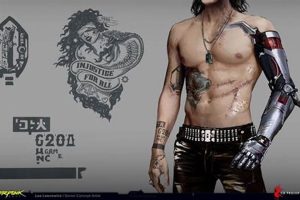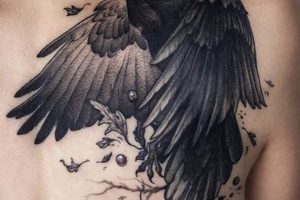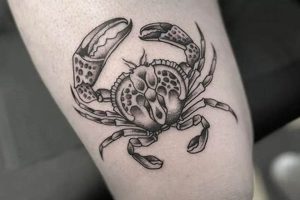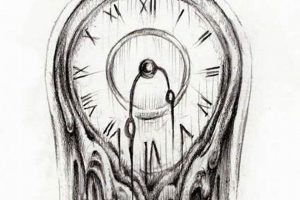Small, strategically placed designs used to complement larger tattoos or fill gaps in existing body art are often referred to as space fillers. These designs can range from simple geometric shapes and floral motifs to intricate patterns and miniature objects. For example, small stars, dots, or leaves can be used to connect disparate elements of a larger piece or to soften harsh lines. They provide a way to achieve a cohesive and balanced aesthetic in a tattoo composition.
These supplementary designs play a significant role in the overall aesthetic of a tattoo. They can create a sense of visual harmony, enhance the flow and composition of a larger piece, and add depth and complexity to the overall design. Historically, smaller, simpler designs often served a similar purpose in traditional tattooing practices around the world, acting as supporting elements within larger, narrative-driven pieces. Their use continues to evolve alongside advancements in tattooing techniques and artistic styles.
This article will further explore the various aspects of these complementary tattoo designs, including popular motifs, placement considerations, and the artistic process involved in their creation.
1. Placement
Strategic placement is paramount when incorporating complementary tattoo designs. The placement of these elements directly impacts the overall composition, flow, and visual balance of the entire piece. Careful consideration of the body’s natural contours and the existing tattoo’s design are essential. For instance, a filler tattoo placed along the curve of a shoulder blade should follow the natural line of the body, enhancing rather than disrupting the overall aesthetic. Similarly, fillers placed around a larger, central design can frame and accentuate the main focus, guiding the viewer’s eye across the composition.
Placement also affects the perceived relationship between the main tattoo and the filler elements. A cluster of small fillers can create a sense of texture and depth, while strategically placed individual elements can connect disparate parts of a larger design, creating a unified narrative. Consider the example of a sleeve tattoo: smaller fillers can bridge the visual gap between larger pieces, ensuring a smooth transition and preventing the overall design from appearing fragmented or disjointed. Careful placement can also be used to balance asymmetry in existing tattoos, creating a more harmonious and visually appealing composition.
Ultimately, successful placement of complementary designs relies on a thorough understanding of both the existing tattoo and the client’s anatomy. It requires an artistic eye and the ability to visualize the final result, ensuring that the fillers enhance, rather than detract from, the overall impact of the tattoo. Neglecting the importance of placement can result in a disjointed and unbalanced composition. Proper placement, however, allows these smaller elements to play a crucial role in creating a cohesive, aesthetically pleasing, and meaningful tattoo.
2. Size and scale
The size and scale of complementary tattoo designs are crucial factors influencing their effectiveness. These elements must be carefully considered in relation to the main tattoo and the overall composition. A filler tattoo that is too large can overpower the main design, disrupting the visual balance and potentially diminishing the impact of the primary artwork. Conversely, a filler that is too small might appear insignificant or even get lost within the larger design. The goal is to achieve a harmonious balance, where the fillers enhance the existing tattoo without competing for attention. For instance, delicate floral fillers surrounding a portrait can add a touch of elegance without overshadowing the subject’s features, while a series of small geometric shapes can create a subtle textural effect around a larger, bolder design.
The scale of the filler elements should also be considered in relation to the client’s body size and the location of the tattoo. A larger individual might require proportionally larger fillers to achieve the desired effect, while a smaller individual might benefit from more delicate, smaller elements. The location also plays a significant role. A small filler on a large expanse of skin, such as the back, might appear lost, while the same filler on a smaller area, like the wrist, could be perfectly proportioned. Practical considerations, such as the future possibility of adding more elements to the tattoo, should also influence size and scale decisions. Leaving sufficient space allows for future additions without creating a cluttered or overcrowded appearance.
Appropriate size and scale contribute significantly to the overall aesthetic and legibility of the entire tattoo. These choices impact not only the visual balance but also the perceived depth and complexity of the design. Challenges arise when fillers are disproportionately sized, leading to an unbalanced and disjointed aesthetic. Understanding the interplay between size, scale, and the overall composition allows artists to create harmonious and visually appealing tattoos where every element, regardless of size, contributes to the intended artistic expression.
3. Design Motifs
Design motifs play a critical role in the effectiveness of complementary tattoo designs. The chosen motif significantly impacts the overall aesthetic and meaning of the tattoo, connecting the filler elements to the larger composition and contributing to a cohesive narrative. A wide range of motifs can be employed, from simple geometric shapes and floral patterns to more intricate depictions of animals, objects, or abstract concepts. The selection of a suitable motif depends heavily on the style and subject matter of the existing tattoo, as well as the client’s personal preferences. For example, geometric patterns can complement a tattoo with strong lines and angles, while delicate floral motifs might be more appropriate for a softer, more flowing design. A skull motif might be chosen to enhance a tattoo with themes of mortality or remembrance, whereas a butterfly could symbolize transformation or rebirth. The chosen motif should resonate with the overall theme, creating a sense of visual harmony and narrative continuity.
The relationship between the main tattoo and the filler motifs can be explored through various artistic techniques. Contrast can be created by juxtaposing different motifs, such as geometric patterns against organic shapes, to add visual interest and depth. Alternatively, harmony can be achieved by using variations of the same motif throughout the tattoo, creating a sense of unity and flow. For example, a large floral tattoo might be complemented by smaller filler flowers of the same species, but in different stages of bloom, adding a subtle layer of symbolism and visual complexity. The skillful use of motifs can also create visual pathways, guiding the viewer’s eye across the composition and connecting disparate elements. Small, repeating motifs can be strategically placed to create a sense of movement and rhythm within the overall design.
Successful integration of design motifs requires a thorough understanding of visual language and symbolic representation. Careful consideration must be given to the meaning and cultural significance of different motifs to ensure they align with the intended message of the tattoo. Challenges can arise when motifs clash stylistically or thematically, resulting in a disjointed and visually confusing composition. A deep understanding of the interplay between design motifs, placement, and the overall theme is crucial for creating a harmonious and meaningful tattoo where every element contributes to the overall aesthetic impact. The effective use of motifs enhances not only the visual appeal but also the depth and complexity of the narrative expressed through the tattoo.
4. Cohesion with Existing Tattoos
Achieving cohesion between existing tattoos and new filler designs is paramount for a harmonious and aesthetically pleasing result. Filler tattoos, while independent design elements, should seamlessly integrate with the existing artwork, enhancing rather than detracting from the overall composition. This requires careful consideration of style, color palette, and thematic consistency.
- Style Consistency
Maintaining a consistent style is crucial for visual harmony. If the existing tattoo features a traditional Japanese style, for example, the filler elements should complement that style, employing similar line weights, color palettes, and imagery. Introducing a drastically different style, such as realism or geometric abstraction, can create a jarring visual disconnect. Consistency in style ensures that the filler tattoos appear as a natural extension of the existing work, contributing to a unified and cohesive aesthetic.
- Color Palette Harmony
The color palette of the filler tattoos should complement the existing ink. This doesn’t necessarily mean using identical colors, but rather selecting shades that harmonize and create a sense of balance. For instance, if the existing tattoo features warm tones, the fillers could incorporate complementary warm shades or contrasting cool tones used strategically to create depth and visual interest. A clashing or disharmonious color palette can disrupt the flow and detract from the overall aesthetic.
- Thematic Continuity
Thematic continuity ensures that the filler tattoos contribute to the overall narrative or symbolic meaning of the existing artwork. If the existing tattoo features a nature theme, for example, filler elements such as leaves, flowers, or insects could enhance the theme and create a more immersive visual experience. Introducing thematically unrelated elements can create a sense of disjointedness and dilute the intended message of the tattoo.
- Visual Flow and Balance
Filler tattoos can be strategically used to improve the visual flow and balance of existing artwork. They can connect disparate elements, fill in awkward gaps, or create a sense of movement and rhythm within the design. Careful placement and sizing of the fillers are essential to achieve this. For instance, a series of small dots or lines can guide the eye across the composition, while strategically placed floral elements can soften harsh lines and create a sense of balance.
By considering these facets, filler tattoos can seamlessly integrate with existing artwork, enhancing the overall aesthetic and creating a cohesive and meaningful piece of body art. Neglecting these aspects can lead to a disjointed and visually jarring result, where the fillers detract rather than enhance the existing tattoos. Cohesion is key to creating a unified and visually compelling composition where every element contributes to the overall narrative and artistic expression.
Tips for Utilizing Complementary Tattoo Designs
Effective integration of smaller, supplementary tattoos requires careful planning and consideration. The following tips provide guidance for achieving cohesive and aesthetically pleasing results.
Tip 1: Consult a Professional Tattoo Artist
Collaboration with a skilled artist is paramount. Artists provide expert guidance on design choices, placement, size, and scale, ensuring harmonious integration with existing tattoos.
Tip 2: Prioritize Placement
Consider the body’s natural contours and the relationship between existing and planned artwork. Strategic placement enhances visual flow and balance.
Tip 3: Size Matters
Proportionality is key. Filler tattoos should complement, not overpower, existing designs. Consider the overall composition and available space.
Tip 4: Motif Selection
Choose motifs that complement the existing tattoo’s style and thematic elements. Consistent motifs create a cohesive narrative.
Tip 5: Color Palette Harmony
Select colors that complement the existing tattoo’s palette. Harmonious colors enhance visual flow and prevent clashes.
Tip 6: Plan for Future Additions
Consider future tattoo plans when selecting placement, size, and motifs. Strategic planning allows for seamless future additions.
Tip 7: Visualize the Final Result
Work closely with the artist to visualize the completed design. Careful visualization ensures the filler tattoos enhance the overall aesthetic.
By following these guidelines, individuals can ensure that complementary tattoos enhance their existing body art, creating a cohesive and visually appealing composition that reflects personal style and artistic vision.
These tips provide a starting point for exploring the potential of complementary tattoo designs. The subsequent conclusion will summarize the key takeaways and underscore the importance of thoughtful planning in the tattooing process.
Frequently Asked Questions about Complementary Tattoo Designs
This section addresses common inquiries regarding the use and application of smaller, supplementary tattoos designed to enhance existing body art.
Question 1: What is the typical cost of a small filler tattoo?
Pricing varies based on factors such as artist experience, geographic location, design complexity, and size. Consulting with a chosen artist is recommended to obtain a precise quote.
Question 2: How long does a small filler tattoo take to heal?
Healing time typically ranges from two to four weeks, similar to larger tattoos. Proper aftercare, as advised by the tattoo artist, is crucial for optimal healing.
Question 3: Can filler tattoos be removed or covered up later?
Removal or cover-up options exist, but the process can be more challenging for smaller designs. Laser removal effectiveness varies based on ink color and skin type. Consultations with a removal specialist are recommended.
Question 4: Are certain body areas better suited for filler tattoos?
Placement depends on individual preference and existing tattoo designs. Areas with ample space and relatively flat surfaces are generally preferred. Discuss placement options with a tattoo artist for personalized recommendations.
Question 5: How does one choose the right design motif for a filler tattoo?
Motif selection should complement the existing tattoo’s style and theme. Consider the overall narrative and visual flow. Consultations with a tattoo artist can assist in selecting an appropriate design.
Question 6: Can filler tattoos be added to any existing tattoo?
While often feasible, the success of integrating filler tattoos depends on factors such as the existing tattoo’s design, available space, and skin condition. A consultation with a tattoo artist is recommended to assess feasibility and discuss design options.
Thorough research and professional consultation are essential for ensuring satisfactory results. Consulting a reputable tattoo artist is highly recommended to discuss individual circumstances and ensure informed decisions.
The following conclusion will summarize key takeaways and offer final recommendations for individuals considering complementary tattoo designs.
Conclusion
Complementary tattoo designs offer a powerful means of enhancing existing body art. Careful consideration of placement, size and scale, design motifs, and cohesive integration with existing work are crucial for achieving a harmonious and aesthetically pleasing result. Strategic placement ensures visual balance and flow, while appropriate sizing maintains proportionality and prevents overcrowding. Motif selection should complement existing themes and styles, creating a cohesive narrative. Color palette harmony and consideration of future additions further contribute to a unified and visually compelling composition. Professional consultation with a skilled tattoo artist is essential for realizing the full potential of these supplementary elements.
The effective use of complementary tattoos elevates body art from a collection of individual designs to a cohesive and expressive canvas. Thoughtful planning and collaboration with a skilled artist ensure that these smaller elements enhance the overall narrative, adding depth, complexity, and visual interest. Ultimately, these seemingly minor additions play a significant role in transforming body art into a powerful form of personal expression.







